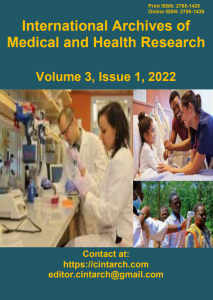
International Archives of Medical and Health Research (IAMHR), pISSN: 2705-1420; eISSN: 2705-1439
July to September 2022 Vol 3(1): pp.1-9 DOI: https://doi.org/10.33515/iamhr/2022.006/01n
Copyright © 2022 C-International Archives
Original Article
Prevalence and factors associated with anaemia among pregnant women attending the Antenatal Care Clinic of UDUTH, Sokoto, Nigeria
Fatima Z. Bello1*, Kehinde J. Awosan1, Amina G. Umar2, Abdulaziz M. Danmadami3, Aisha Attahiru3, Ebigide C. David1, Abubakar Lawal1
1Department of Community Health, UsmanuDanfodiyo University, Sokoto, Nigeria
2Department of Obstetrics and Gynecology, UsmanuDanfodiyo University, Sokoto, Nigeria
3Department of Community Medicine, Usmanu Danfodiyo University Teaching Hospital, Sokoto, Nigeria
*Corresponding Author’s Email: phateemaxahra@gmail.com
Published September 30, 2022
ABSTRACT
Background: Pregnancy-related anaemia is a significant global public health concern, especially in underdeveloped nations where it significantly increases maternal morbidity and mortality. Aim: This study aimed to determine the prevalence and factors associated with anaemia among pregnant women attending the Antenatal Care Clinic of UDUTH, Sokoto, Nigeria. Materials and Methods: A facility-based cross-sectional study was conducted among 297pregnant women selected by systematic sampling technique. A structured interviewer-administered questionnaire was used to obtain information on the research variables, while the participants’ haemoglobin concentration was extracted from their case files. Data were analyzed using IBM SPSS version 25 statistical computer software package. Results: About two-thirds, 186 (62.6%) of the 297 pregnant women were anaemic. Of these, 116 (62.4%) had mild anaemia, while 70 (37.6%) had moderate anaemia. The factors associated with anaemia were not being employed, multiple gestations, being in the early stages of pregnancy, not using iron supplements, not having complete doses of intermittent preventive treatment for malaria, not sleeping under insecticide-treated nets consistently, and recent treatment for malaria. Conclusion: This study showed a high prevalence of anaemia among pregnant women attending the antenatal clinic of UDUTH Sokoto, Nigeria, and it was associated with several sociodemographic and obstetric factors. The findings of this study underscore the need for a multipronged approach to the prevention of anaemia among pregnant women, including women empowerment to facilitate access to good nutrition, iron supplementation, intermittent preventive treatment of malaria (IPTp-SP), and promotion of consistent use of insecticides treated nets (ITNs).

